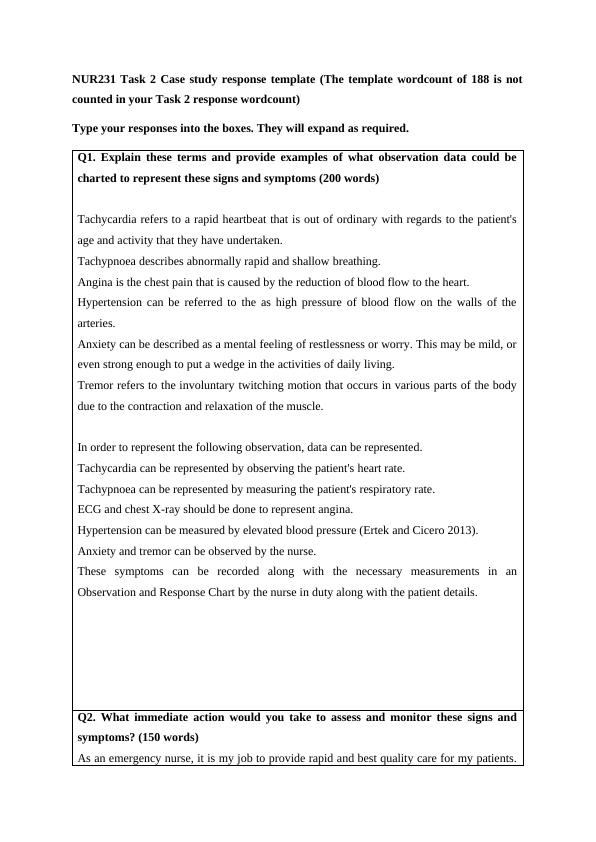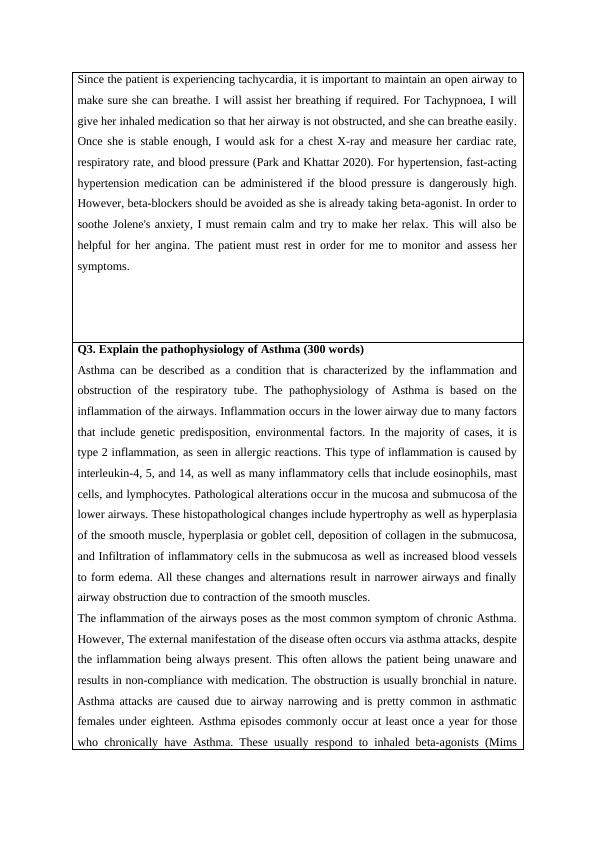NUR231 Case Study Response Template
Added on 2022-08-21
8 Pages2455 Words10 Views
NUR231 Task 2 Case study response template (The template wordcount of 188 is not
counted in your Task 2 response wordcount)
Type your responses into the boxes. They will expand as required.
Q1. Explain these terms and provide examples of what observation data could be
charted to represent these signs and symptoms (200 words)
Tachycardia refers to a rapid heartbeat that is out of ordinary with regards to the patient's
age and activity that they have undertaken.
Tachypnoea describes abnormally rapid and shallow breathing.
Angina is the chest pain that is caused by the reduction of blood flow to the heart.
Hypertension can be referred to the as high pressure of blood flow on the walls of the
arteries.
Anxiety can be described as a mental feeling of restlessness or worry. This may be mild, or
even strong enough to put a wedge in the activities of daily living.
Tremor refers to the involuntary twitching motion that occurs in various parts of the body
due to the contraction and relaxation of the muscle.
In order to represent the following observation, data can be represented.
Tachycardia can be represented by observing the patient's heart rate.
Tachypnoea can be represented by measuring the patient's respiratory rate.
ECG and chest X-ray should be done to represent angina.
Hypertension can be measured by elevated blood pressure (Ertek and Cicero 2013).
Anxiety and tremor can be observed by the nurse.
These symptoms can be recorded along with the necessary measurements in an
Observation and Response Chart by the nurse in duty along with the patient details.
Q2. What immediate action would you take to assess and monitor these signs and
symptoms? (150 words)
As an emergency nurse, it is my job to provide rapid and best quality care for my patients.
counted in your Task 2 response wordcount)
Type your responses into the boxes. They will expand as required.
Q1. Explain these terms and provide examples of what observation data could be
charted to represent these signs and symptoms (200 words)
Tachycardia refers to a rapid heartbeat that is out of ordinary with regards to the patient's
age and activity that they have undertaken.
Tachypnoea describes abnormally rapid and shallow breathing.
Angina is the chest pain that is caused by the reduction of blood flow to the heart.
Hypertension can be referred to the as high pressure of blood flow on the walls of the
arteries.
Anxiety can be described as a mental feeling of restlessness or worry. This may be mild, or
even strong enough to put a wedge in the activities of daily living.
Tremor refers to the involuntary twitching motion that occurs in various parts of the body
due to the contraction and relaxation of the muscle.
In order to represent the following observation, data can be represented.
Tachycardia can be represented by observing the patient's heart rate.
Tachypnoea can be represented by measuring the patient's respiratory rate.
ECG and chest X-ray should be done to represent angina.
Hypertension can be measured by elevated blood pressure (Ertek and Cicero 2013).
Anxiety and tremor can be observed by the nurse.
These symptoms can be recorded along with the necessary measurements in an
Observation and Response Chart by the nurse in duty along with the patient details.
Q2. What immediate action would you take to assess and monitor these signs and
symptoms? (150 words)
As an emergency nurse, it is my job to provide rapid and best quality care for my patients.

Since the patient is experiencing tachycardia, it is important to maintain an open airway to
make sure she can breathe. I will assist her breathing if required. For Tachypnoea, I will
give her inhaled medication so that her airway is not obstructed, and she can breathe easily.
Once she is stable enough, I would ask for a chest X-ray and measure her cardiac rate,
respiratory rate, and blood pressure (Park and Khattar 2020). For hypertension, fast-acting
hypertension medication can be administered if the blood pressure is dangerously high.
However, beta-blockers should be avoided as she is already taking beta-agonist. In order to
soothe Jolene's anxiety, I must remain calm and try to make her relax. This will also be
helpful for her angina. The patient must rest in order for me to monitor and assess her
symptoms.
Q3. Explain the pathophysiology of Asthma (300 words)
Asthma can be described as a condition that is characterized by the inflammation and
obstruction of the respiratory tube. The pathophysiology of Asthma is based on the
inflammation of the airways. Inflammation occurs in the lower airway due to many factors
that include genetic predisposition, environmental factors. In the majority of cases, it is
type 2 inflammation, as seen in allergic reactions. This type of inflammation is caused by
interleukin-4, 5, and 14, as well as many inflammatory cells that include eosinophils, mast
cells, and lymphocytes. Pathological alterations occur in the mucosa and submucosa of the
lower airways. These histopathological changes include hypertrophy as well as hyperplasia
of the smooth muscle, hyperplasia or goblet cell, deposition of collagen in the submucosa,
and Infiltration of inflammatory cells in the submucosa as well as increased blood vessels
to form edema. All these changes and alternations result in narrower airways and finally
airway obstruction due to contraction of the smooth muscles.
The inflammation of the airways poses as the most common symptom of chronic Asthma.
However, The external manifestation of the disease often occurs via asthma attacks, despite
the inflammation being always present. This often allows the patient being unaware and
results in non-compliance with medication. The obstruction is usually bronchial in nature.
Asthma attacks are caused due to airway narrowing and is pretty common in asthmatic
females under eighteen. Asthma episodes commonly occur at least once a year for those
who chronically have Asthma. These usually respond to inhaled beta-agonists (Mims
make sure she can breathe. I will assist her breathing if required. For Tachypnoea, I will
give her inhaled medication so that her airway is not obstructed, and she can breathe easily.
Once she is stable enough, I would ask for a chest X-ray and measure her cardiac rate,
respiratory rate, and blood pressure (Park and Khattar 2020). For hypertension, fast-acting
hypertension medication can be administered if the blood pressure is dangerously high.
However, beta-blockers should be avoided as she is already taking beta-agonist. In order to
soothe Jolene's anxiety, I must remain calm and try to make her relax. This will also be
helpful for her angina. The patient must rest in order for me to monitor and assess her
symptoms.
Q3. Explain the pathophysiology of Asthma (300 words)
Asthma can be described as a condition that is characterized by the inflammation and
obstruction of the respiratory tube. The pathophysiology of Asthma is based on the
inflammation of the airways. Inflammation occurs in the lower airway due to many factors
that include genetic predisposition, environmental factors. In the majority of cases, it is
type 2 inflammation, as seen in allergic reactions. This type of inflammation is caused by
interleukin-4, 5, and 14, as well as many inflammatory cells that include eosinophils, mast
cells, and lymphocytes. Pathological alterations occur in the mucosa and submucosa of the
lower airways. These histopathological changes include hypertrophy as well as hyperplasia
of the smooth muscle, hyperplasia or goblet cell, deposition of collagen in the submucosa,
and Infiltration of inflammatory cells in the submucosa as well as increased blood vessels
to form edema. All these changes and alternations result in narrower airways and finally
airway obstruction due to contraction of the smooth muscles.
The inflammation of the airways poses as the most common symptom of chronic Asthma.
However, The external manifestation of the disease often occurs via asthma attacks, despite
the inflammation being always present. This often allows the patient being unaware and
results in non-compliance with medication. The obstruction is usually bronchial in nature.
Asthma attacks are caused due to airway narrowing and is pretty common in asthmatic
females under eighteen. Asthma episodes commonly occur at least once a year for those
who chronically have Asthma. These usually respond to inhaled beta-agonists (Mims

2015). The asthma attacks may be moderate or mild or severe (Bryant and Knights 2014).
In the case of Jolene, it was revealed that she was admitted to the facility for her Asthma in
her adolescence multiple times. So it is possible that some of her symptoms are related.
Q4. Provide the generic details of these medications and explain their indication and
action (200 words)
Ventolin is a spray medication used as an antiasthmatic agent. It is usually used during
asthma attacks. The spray acts within 15 minutes and works for a couple of hours up to
around six hours. This medication works by relaxing the smooth muscles and thus opening
up the airways to the lungs. This helps the patient inhale easier and thus, can be used
during asthma attacks (nhs.uk, 2020).
Serevent is a beta-adrenergic receptor agonist that is utilized to manage the symptoms of
Asthma and the reduction of obstruction of airways. It stimulates the beta2 adrenergic
receptors. This leads to an increase in the level of cyclic AMP. This ultimately results in
the relaxation of the smooth muscles, leading to the opening up of the airways (Currie and
Lipworth 2016).
Atrovent, also known as ipratropium bromide, is a medication that is used via an inhaler or
even a nebulizer. It is used to treat the symptoms of Asthma. It is anticholinergic in nature,
and likely inhibits reflexes mediated by the vegas nerve. This happens with the medication
acting as an antagonist for the action of acetylcholine, which is a neurotransmitter. This
medication works by opening the airways so that the patient can breathe better
(Medicines.org.uk 2020).
In the case of Jolene, it was revealed that she was admitted to the facility for her Asthma in
her adolescence multiple times. So it is possible that some of her symptoms are related.
Q4. Provide the generic details of these medications and explain their indication and
action (200 words)
Ventolin is a spray medication used as an antiasthmatic agent. It is usually used during
asthma attacks. The spray acts within 15 minutes and works for a couple of hours up to
around six hours. This medication works by relaxing the smooth muscles and thus opening
up the airways to the lungs. This helps the patient inhale easier and thus, can be used
during asthma attacks (nhs.uk, 2020).
Serevent is a beta-adrenergic receptor agonist that is utilized to manage the symptoms of
Asthma and the reduction of obstruction of airways. It stimulates the beta2 adrenergic
receptors. This leads to an increase in the level of cyclic AMP. This ultimately results in
the relaxation of the smooth muscles, leading to the opening up of the airways (Currie and
Lipworth 2016).
Atrovent, also known as ipratropium bromide, is a medication that is used via an inhaler or
even a nebulizer. It is used to treat the symptoms of Asthma. It is anticholinergic in nature,
and likely inhibits reflexes mediated by the vegas nerve. This happens with the medication
acting as an antagonist for the action of acetylcholine, which is a neurotransmitter. This
medication works by opening the airways so that the patient can breathe better
(Medicines.org.uk 2020).

End of preview
Want to access all the pages? Upload your documents or become a member.
Related Documents
Questions-Answers on Drug Therapy | Studylg...
|11
|2569
|22
Assessment Center Case Studies Practicelg...
|9
|2624
|16
Case study response templatelg...
|10
|2613
|16
Medical Health | Assignmentlg...
|8
|2319
|21
Case Study: Definition, Exampleslg...
|11
|2612
|13
Pathophysiology of Asthma and Graves’ Diseaselg...
|8
|2257
|65